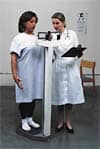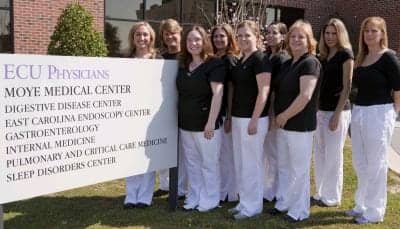A step-by-step account of the AASM accreditation process describes what first-time facilities can anticipate when the academy comes knocking.

There are currently more than 735 sleep disorder programs in the United States that are accredited by the American Academy of Sleep Medicine (AASM), and that number continues to grow as more sleep programs pursue AASM accreditation. AASM accreditation is considered the “gold standard” in sleep disorders medicine for a number of reasons including its exclusive focus on sleep disorder programs and the involvement of sleep specialists. Additionally, many programs pursue AASM accreditation for peer recognition or to meet third-party payor requirements.
The process of AASM accreditation is relatively straightforward, although it can seem rather daunting for those seeking accreditation for the first time. The steps include submission of the application, the site visit approval, the actual site visit, and receipt of the recommendation concerning accreditation. The entire process can be completed in a matter of months, depending to a large extent on the facility’s responsiveness and flexibility for hosting a site visit.
Application Process
The first step toward AASM accreditation is the purchase of the accreditation application from the AASM’s national office, which can be done online through the AASM Web site (www.aasmnet.org). There are different applications for laboratory or center accreditation, so it is up to the sleep program whether to apply as a center or laboratory. If the program does not have a Diplomate of the American Board of Sleep Medicine (DABSM) on staff or someone accepted to take the boards, they can apply only as a laboratory for sleep-related breathing disorders. They will then have 3 years after accreditation to acquire a DABSM on their staff. If a program already has a DABSM on staff or someone accepted to take the boards, they may apply as a center or a laboratory. It is usually more advantageous to the program to apply as a center since the standards are almost identical and it allows centers to advertise services for all sleep disorders. By contrast, breathing disorders laboratories are restricted to advertising their services for sleep-related breathing disorders, but they must still be able to recognize all disorders and have a mechanism for treating them.
Completing the Application
The application is really a self-assessment questionnaire that consists of simple yes or no questions and a few forms and appendices. The questions follow the standards for accreditation, and the program should be able to answer yes to all questions. The yes or no format of the application helps the program identify deficiencies that do not meet the standards so they can make the necessary changes to meet the standards prior to submission and the site visit. The standards cover various areas including personnel, continuing education, polysomnographic recording, scoring, the physical facility, equipment, patient care, and emergency plans. If there are any questions about the standards or how to meet them, the program can call the accreditation coordinator at the AASM national office for help and clarification.
The application takes time to complete. Although circling the answer to each question can be done quickly, gathering the information for the forms and appendices can be time-consuming. The forms require data gathered from the program’s database as well as a listing of personnel and equipment. The appendices include sample patient cases, job descriptions, and protocols and procedures for polysomnography and emergencies. The bulk of the appendices consists of four patient cases. The samples should include the patient’s history and physical examination or sleep questionnaire equivalent, the results of the sleep study, and follow-up information. The cases provide information about the general quality of patient care provided by the program, so the cases submitted are very important.
When completed, the application must be signed by the medical director and other key personnel. The medical director should personally review the information submitted in the application as they are considered responsible for its contents, even if they did not personally complete the application. Prior to submitting the application, the program should call the national office to let them know that the application is being sent. Four copies of the application will need to be submitted along with payment for the site visit.
Once the application is received by the AASM national office, the application will be sent to reviewers from the accreditation committee who will read the entire application. The reviewers will determine if all of the requested information is submitted and it appears that the facility meets the standards for accreditation. If so, the program will be approved for a site visit. If there are omissions in the application, it may be returned to the facility for completion. If some information is contradictory, unclear, or partially complete, the facility will receive a letter with a list of queries on the various issues that they will need to answer. Review of most applications generally results in some queries back to the center. These queries are valuable to the center, as they often identify things that may not meet standards, and this allows the program to fix them before the site visit.
The initial review process takes a couple of weeks. If queries are generated, additional time is needed for the center to respond and for the responses to be reviewed. Consequently, it is important for the program to respond as quickly as possible to minimize the amount of time required to complete the entire accreditation process.
After the reviewer is satisfied that the program is in compliance with the standards for accreditation, the program will be approved for a site visit. At that point, the national office will contact the facility with a site visit date. If the facility accepts the date, the site visit is scheduled. If the facility cannot accept the date offered, another date will be offered, but it will typically be a later date. All professional personnel should be present for the site visit, so before accepting a date, the availability of the professional staff should be determined.
The program will receive written confirmation of the site visit along with preparation instructions. At least 1 week prior to the site visit, the program will need to send a schedule of the site visit activities and names of individuals including consultants and an administrator who will be interviewed by the site visitor.
The Site Visit
For programs undergoing the initial accreditation, there is an evening and morning session with the site visitor. The site visit will start in the evening when the site visitor is picked up at the hotel around 8 pm by a staff member of the sleep program. The site visit begins when the visitor is picked up, so the individual doing this should be familiar with the operation of the program.
When the visitor arrives at the site, they will tour the facility. The visitor will be evaluating the adequacy of the space, appropriateness of the layout, and general appearance of the facility, especially as seen from the patient’s perspective. Any concerns about maneuverability for emergency personnel, convenience of bathroom facilities, and adequacy of sound and light attenuation in bedrooms will be addressed. The visitor will want to get an overview of how the program operates in terms of patient referrals, scheduling, and staffing of professional, technical, and administrative personnel. During the course of the evening, the visitor will intermittently watch the hookup of patient(s) arriving for sleep studies. They will be attentive to the interaction between the technician and the patient, as well as the hookup procedure. The visitor will watch the start of the night study, and view the calibration process and operation of the recording equipment by the technician. Between these activities, the visitor will want to review the policy and procedure manual as well as patient charts. The evening visit concludes about midnight.
The next morning, the visit resumes around 8 am. The visitor will review the records from the preceding night with one of the interpreting physicians operating the computer. The visitor will also need to observe all interpreting physicians and the DABSM operating the computerized sleep system. Random charts will also be pulled to examine the completeness of charts (including history and physical examination/sleep questionnaire, study results, follow-up information, and consultant notes) and quality of the evaluations in terms of meeting all standards. During the course of the morning, the consultants will be individually interviewed in private by the visitor for about 15 minutes. The discussion will usually center on the working relationship between the program and the physician. An interview with the administrator of the program will also be conducted, which focuses on support for the new program.
After the visitor has gathered all necessary information, they will evaluate the program’s compliance with all standards by completing the standards checklist indicating the level of compliance with each standard. This objective checklist is identical to the standards that the facility receives with the accreditation application, so there should be no surprises for the program.
An exit meeting is held between the site visitor, medical director, and any other interested program personnel. The visitor will provide a summary of strengths and weakness of the program and answer any questions. The facility will receive a final report granting or denying accreditation in about 6 to 8 weeks. The visitor does not grant accreditation, but only makes a recommendation to the accreditation committee. The chair of the accreditation committee reviews the site visit report and makes a final recommendation concerning accreditation to the board of directors of the AASM. It is the board that grants accreditation and the notification will come from the board. Consequently, the visitor cannot tell a program at the close of the site visit that they will or will not receive accreditation.
Accreditation Notification
The accreditation notification letter may indicate accreditation, accreditation with provisos, or denial of accreditation. The letter will summarize the activities of the site visit and list the strengths and weakness of the program. If some of the weaknesses rise to the level of a proviso based on the scoring for the standards, accreditation with provisos will be given. Provisos are deficiencies that must be corrected for the facility to maintain accreditation and the facility will be given 3 months to bring the program into compliance. Specific information will be requested to be sent to the national office that indicates compliance has been met. This information will be reviewed by the original site visitor who will determine if the proviso is removed. If a program is not granted accreditation, they can contact the national office concerning their options if they want to continue pursuing AASM accreditation. The national office and accreditation committee will gladly work with all programs to help them meet the standards for accreditation.
Donna Arand, PhD, is clinical director of Kettering Sleep Disorders Center, Dayton, Ohio.
Disclosure Statement
The author is a former chair of the AASM Accreditation Committee. Currently, the author serves on the American Academy of Sleep Medicine (AASM) board of directors that sets standards for accreditation and also serves as the board liaison to the AASM Accreditation Committee.
The information in this article is believed to be consistent with AASM standards for accreditation and accreditation process; however the information, views, and opinions in this chapter represent only those of the author and do not represent an official statement of the AASM or its committees.




